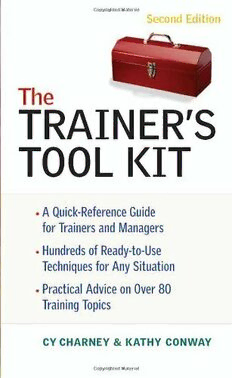Table Of ContentThe
Trainer’s
Tool Kit
Second Edition
Cy Charney
and
Kathy Conway
American Management Association
NewYork•Atlanta•Brussels•Chicago•MexicoCity•SanFrancisco
Shanghai•Tokyo•Toronto•Washington,D.C.
..........................10916$ $$FM 10-21-0407:57:51 PS PAGEi
SpecialdiscountsonbulkquantitiesofAMACOMbooksare
availabletocorporations,professionalassociations,andother
organizations.Fordetails,contactSpecialSalesDepartment,
AMACOM,adivisionofAmericanManagementAssociation,
1601Broadway,NewYork,NY10019.
Tel.:212-903-8316.Fax:212-903-8083.
Website:www.amacombooks.org
Thispublicationisdesignedtoprovideaccurateandauthoritative
informationinregardtothesubjectmattercovered.Itissoldwiththe
understandingthatthepublisherisnotengagedinrenderinglegal,
accounting,orotherprofessionalservice.Iflegaladviceorotherexpert
assistanceisrequired,theservicesofacompetentprofessionalperson
shouldbesought.
LibraryofCongressCataloging-in-PublicationData
Charney,Cyril
Thetrainer’stoolkit/CyCharneyandKathyConway.—2nded.
p. cm.
Includesindex.
ISBN0-8144-7268-0(pbk.)
1. Employees—Trainingof—Handbooks,manuals,etc. I. Conway,
Kathy. II. Title.
HF5549.5.T7C5412 2005
658.3(cid:1)124—dc22
2004018328
(cid:2)2005CyCharneyandKathyConway
Allrightsreserved.
PrintedintheUnitedStatesofAmerica.
Thispublicationmaynotbereproduced,
storedinaretrievalsystem,
ortransmittedinwholeorinpart,
inanyformorbyanymeans,electronic,
mechanical,photocopying,recording,orotherwise,
withoutthepriorwrittenpermissionofAMACOM,
adivisionofAmericanManagementAssociation,
1601Broadway,NewYork,NY10019.
Printingnumber
10 9 8 7 6 5 4 3 2 1
..........................10916$ $$FM 10-21-0407:57:52 PS PAGEii
Contents
Preface vii
Acknowledgments ix
PARTI: TRAININGTODAY 1
Today’s Organizations 3
Today’s Trainers 5
Today’s Trainees 6
Training Trends—Then and Now 9
Learning Organizations 12
Successful Training Criteria 14
PARTII: ALIGNINGTRAININGWITHTHE
ORGANIZATION’SOBJECTIVES 17
Linking Training to Business Needs 19
Aligning Trainers with the Organization 21
Training Needs Analysis 23
Designing a Training Needs Analysis 26
Using 360-Degree Feedback for Training Needs
Analysis 29
Core Competencies 31
Developing a Training Curriculum 34
PARTIII: MAXIMIZINGTHETRAININGINVESTMENT 39
Budgeting for Training 41
Budgets: Building a Case for More Training Dollars 45
iii
..........................10916$ CNTS 10-21-0407:57:57 PS PAGEiii
iv Contents
Costs and Benefits of Training 47
Alternatives to Training 50
Stretching the Training Dollars 52
Using Consultants 53
Outsourcing 57
Choosing Facilities 59
Requests for Proposals for Training Services 61
PARTIV: DEVELOPINGTRAININGPROGRAMS 65
Lesson Plan Development 67
Training Program Design 69
Methodology—Choosing the Right One 72
Role Play: Design and Conduct 74
Case Studies 77
Training Materials 78
Simulations 80
Pilot Programs 82
PARTV: DELIVERYOPTIONS 85
Technology: Choosing High-Tech or Low-Tech 87
E-Learning 89
Videoconferencing 94
Self-Directed Learning 96
Computer-Based Training 99
PARTVI: CONDUCTINGTRAINING 101
Preparation for Training 103
Icebreakers 104
Overcoming Nervousness 106
Impact in the Classroom 108
Videos: Using Them to Their Best Advantage 110
Dealing with Difficult Behavior 113
Resistance to Training 116
Keeping Trainees Focused 118
Flip Chart Do’s and Don’ts 121
Overhead Projector Do’s and Don’ts 122
Activities and Exercises 123
..........................10916$ CNTS 10-21-0407:57:57 PS PAGEiv
Contents v
Computer-Projected Presentations 125
Presentation Skills 127
Facilitator Do’s and Don’ts 130
Top 10 Tips for Trainers 132
Humor 134
Diversity in the Classroom 136
Post-Course Evaluation 138
PARTVII: SPECIALIZEDTRAININGCOURSES 143
Orientation 145
Product Training 147
Outdoor Training 149
Conferences and Seminars 152
PARTVIII: EVALUATINGTHEIMPACTOFTRAINING
ONPERFORMANCEIMPROVEMENT 155
Targeting the Right Results 157
Levels of Evaluation 158
Measuring Training Results 163
Auditing the Training Function 165
Benchmarking 170
PARTIX: DEVELOPINGTRAINERSANDFACILITATORS 175
Train-the-Trainer Sessions 177
Professional Development for Trainers and
Facilitators 179
Professional Associations: A Checklist for Selecting
and Joining 181
PARTX: SUSTAININGTHEIMPACTOFTRAINING 183
Manager’s Role in Supporting Training 185
Coaching for Skills Development 186
Individual Development Plans 188
The Development Planning Meeting 190
Making the Most of Development Planning Meetings 195
Developmental Learning Activities 197
..........................10916$ CNTS 10-21-0407:57:57 PS PAGEv
vi Contents
PARTXI: GROWINGORGANIZATIONCAPACITY 201
Mentoring Best Practices 203
Implementing a Mentoring Program 206
Training and Orientation for Mentors and Mentees 209
Career Planning Programs 211
Promoting Career Self-Management 213
Succession Planning 215
Designing an In-House Succession Program 218
Ten Ways to Take the ‘‘Success’’ out of Succession
Planning 221
Energizing High Performers Through Training and
Learning Opportunities 223
Index 227
..........................10916$ CNTS 10-21-0407:57:58 PS PAGEvi
Preface
E
xpectationsabouttrainingpracticesandsolutionshave changed
dramaticallyinthepastfewyears.Organizationsregularlyrede-
fine the terms success and performance to meet evolving client and
employeeexpectations.
Atthesametime,thenumberoftrainingoptionsfortransferring
learning has mushroomed so that e-learning, distance learning, vid-
eoconferencing,andself-directedprogramsarebecomingmorecom-
monplaceascomparedwiththetraditionalclassroomsetting.
Thetermtrainingitselfhasbeenbroadenedtothemoreinclusive
term of learning—denoting a broader base of skill-building opportu-
nities through assignments, activities, and focused coaching. This
shift has broadened the responsibility for training to include manag-
ers, coaches, role models, and mentors as key learning agents. An
employee’s manager has the ultimate responsibility for supporting
and sustaining development. As a result, skill sets for managers re-
flectthisimportantresponsibility.
Manyorganizations nowregardtheirsupportforindividualde-
velopmentandskillsupgradingascompetitiveadvantagesinattract-
ingandretaininghighperformers.Thependingretirementsofmany
baby boom employees in the next ten years has necessitated the im-
portance of retaining organizational memory and knowledge man-
agementthroughsuccession-planningprograms.Atthesametime,a
newer generation of workers has been educated and trained differ-
ently,therebyrequiringtrainingopportunitiesthatarecustomizedto
match learning-style preferences. Both the organization and its em-
ployeeswantbusiness-basedoutcomesthatreducecost.
Training today is typically not measured as a stand-alone proc-
ess. Measures of success are becoming more focused on training’s
vii
..........................10916$ PREF 10-21-0407:58:01 PS PAGEvii
viii Preface
contribution to—and integration with—other human resource prac-
tices. Training must create visible bridges between skills building,
corecompetencies,andperformancemanagement.Continuouslearn-
ingimpliesthattraining’smissionisnottoonlyclosegapsbutalsoto
grow organizational capacity by preparing employees for emerging
challenges.
Today’s trainers (and everyone is a trainer today at some point)
inevitably operate in environments that present new challenges and
opportunities. Nevertheless, they still must meet standards that have
notchanged,suchasengagingparticipants,creatinganenvironment
that encourages learning, risk taking, practice, and checking for un-
derstanding. Most important, trainers must enhance organizational
capacity—onetraineeatatime.
Thisbookis forthem.
..........................10916$ PREF 10-21-0407:58:01 PS PAGEviii

